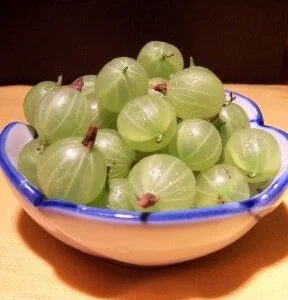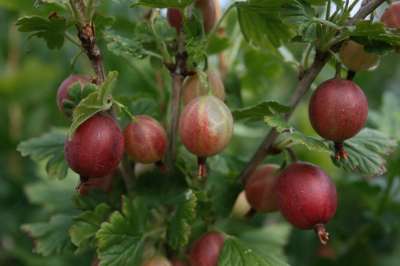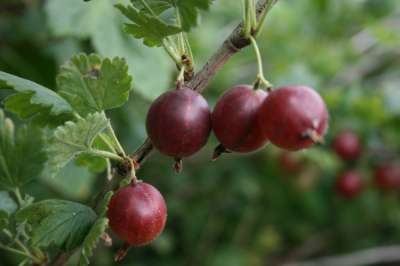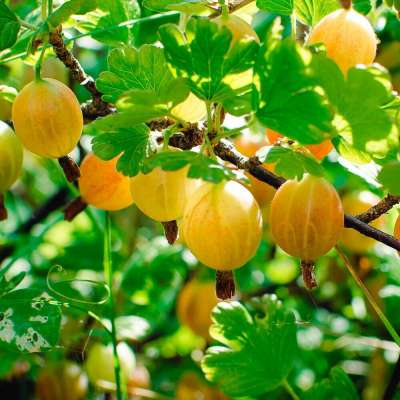Your basket is currently empty!
Most of us have at least some shade in our gardens; sometimes it can be difficult to get too inspired with these spaces and usually it’s ground cover subjects or classic shade loving plants like hostas or ferns that get the nod to fill these problem spots. Lovely though they are, you might want to think about putting these areas to a more fruitful [ahem] use. It might at first surprise you that fruits – often seen as loving to bask in the sunshine – could do well in more gloomy spaces at all. But if you think about it, many of the species and families that share their ancestry with todays popular fruiting plants have their origins firmly as woodland and hedgerow plants.
Fruit gardening in towns
Shady places can be so for many reasons. Maybe if you live in a built up area your gardening space may be overshadowed by tall buildings, or confined even to an alleyway. Even here you can grow your delicious fruit plants in pots with little or no sun. Follow this guide and you can get more than worthwhile results. What a lovely decadent oasis can be created with just a little imagination and a dash of enthusiasm, even in the midst of the smoky city.
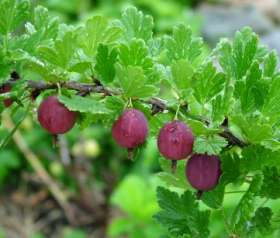
North facing walls
Usually provide a lot of shade, not only to the wall itself, but the growing area in front of it. They can be cool and damp, and this isn’t necessarily a bad thing as most fruits need a reliable source of moisture to swell and become juicy. And the harvest season can be longer than their counterparts grown in full sun where the fruits ripen far more quickly.
Hedgerow fruits
This is often the most common environment, but it can be a very useful one to grow lots of different productive plants and trees. Gardening beneath trees themselves is often the most challenging environment but when you get it right can look wonderful. The main problem here is not so much the shade, as the soil beneath. There can be little surface soil in which to plant, and or it may be very dry. So the key to success is to excavate panting holes as well as you can, infil with good compost and top soil and ensure regular watering until the plants are well established./ Thereafter the subjects capable of growing in these conditions are often able to withstand the dryness, but they need to become established first. From this aspect it is better to plant in the Autumn and winter, when the leaves are off the trees and the rain can get down to settle the plants in. In areas where the tree canopy is less dense, with dappled shade and the trees are more intermittently established, it will be easier to grow things. As for the shade at the foot of established hedges, this can be home to smaller fruit plants that can happily fit in, int a more natural setting.
Good fruit plants and trees for sunless areas
Strawberries
Sun loving strawberries adapt well to a life with little or no sun. The alpine strawberry that gave rise to todays bigger, plumper hybrid varieties, continues to love life beneath trees and hedges. This preference has to a certain extent filtered through to more modern day varieties. Through trials, I have found older more vigorously growing types such as Gorella, Cambridge Vigour, Royal Sovereign, Talisman, Red Gauntlet and Cambridge Vigour are particularly adapted to shady spots and left to their own devices spread by way of their runners and form natural looking colonies and carpets, studded with delicious berries during June and July! They can also be grown in individual pots and stood on the shady patio or walkway with no problem at all.
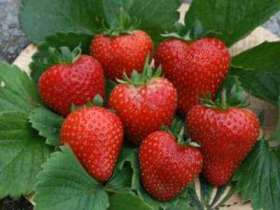
Raspberries
Can do very well with a lack of sun, you can plant them at the foot of a hedge or near to a North wall, or in a shady border, anywhere where the height of the canes can be accommodated. Remember they will grow 6’ or more, and they will spread underground by way of new canes each year. They can be grown as self sufficient in more natural areas and also thrive in the wild garden. Self supporting varieties are therefore best as a post and wire system normally used in more formal area’s may not be so appropriate. So go for varieties like Malling Jewel, Polka, Autumn Bliss, Octavia and Zeva which are either more compact or stronger of stem.
The cooking cherry Morello
This is the classic tree for North wall, and you can grow it either against the wall itself, or as a free standing tree in front of it. You can also keep a small tree in a pot in any shady area. If you want to fan train it against the wall you will need an area of 2metres high and wide to accommodate it. As for freee standing trees you have the choice of a more vigorously growing Colt stock tree [estimated height 3 metres] or a nice dwarfing tree on Gisela – which can be grown in the ground free standing, or in a 20 litre capacity container. Morello remains by far the most popular cooking cherry, but there is a newer productive type too called Nabella. Both are self fertile so it doesn’t matter if you only have one cherry tree. The fruits ripen in July and are superb for pies, jams and juicing. Although on the sharp side, many like to eat them fresh too.
Cherry Plum Myrobalum – hedgerow specialist
Neither a cherry or a plum, this is a wild type fruit you may sometimes come across in nature growing a hedge or old woodland. It’s a real shady specialist and loves to grow on the Northside, or in dappled shade. It is called a cherry plum because the fruits are the same size and shape as a cherry but have a flesh that is more like a plum. They come in red and yellow varieties. You can harvest them and eat straight from the tree, but perhaps they are at their finest made into jams. Cherry Plum jam was a great favourite many years ago. These are hardy, prolific and long lived trees, self pollinating and not needing to much aftercare. Usually quite vigorously and free growing to 3+ metres, these days you can also buy them on dwarfing [Pixy] stock so you can even grow on in a 20 litre capacity container with no trouble. Variety ‘de Nancy’ is a good red, whilst Golden Sphere is yellow.
Blackberries
Perhaps not too much of a surprise inclusion, these are very easy soft fruits to grow in the shade. Most varieties need some support so you can grow them on an East or North facing wall, but lower varieties like Waldo or Loch Ness can be planted and left to romp away under the tree canopy of open shady border. Thorny types like Ashton Cross – derived from a wild blackberry – do particularly well as does John Innes.
Blackcurrants, easy growing and adaptable
Great results from most varieties can be had with a distinct lack of sun, infact in many cases cropping can be equivalent fo bushes grown in the open. Cropping is scarcely affected and the berries do not need sunshine to develop the aromatic flavour. Strong growing varieties like Ben Nevis, Ben More, Goliath, Silvergeiters Zwarte and Wellington XXX are particularly recommended. Blackcurrants grown in shade are often less troubled by frost damage to the flowers as sunshine does not melt the frost too quickly from the flower buds in Spring, which is often the primary cause of damage in sunny areas. You can definitely consider growing Blackcurrants in the shady border. If you want to confine them to a pot, then Ben Sarek is the best one to go for as it is more compact.
Gooseberries
The doughty gooseberry bush will establish in the shade with no trouble at all and prove a productive investment for many years. They are low maintenance too as not much pruning is required. I would keep to the green or white skinned varieties rather than the red as the latter ripen better in the sunshine. Varieties like Invicta, Greenfinch, Howards Lancer, Whitesmith and Careless are ideal for shade and these tartly flavoured beauties are all classics for pies, crumbles and preserves. They can be grown as free standing bushes or as cordons if you are short on space. The latter are particularly suited to 10 litre containers with a bamboo cane as support, or planted against a gloomy wall or fence.
Hazelnuts and Filberts the woodland specialists
An integral part of woodland across the country so you will have no problem growing these in shade. Varieties like Cosford Cob, Kentish Cob and Gunslebert are particularly good and will do very well indeed. The wonderful display of drooping tassel like catkins in early spring, and rich gold autumn colour, make these attractive additions to the woodland garden, back of a shady border or mixed hedge, and of course the bountiful harvest of tasty nuts in November is a real treat. You can also grow the slightly smaller variety ‘di giffoni’ in a 25 litre capacity container for many years.
Walnuts and chestnuts are also suitable in larger shaded areas but beware the Almond which demands full sun to thrive!
Crab apples
Again some species have their origins in woodland and hedgerow so there are some modern day varieties that happily grow in a life with little or no sun. Avoid the purple leaved varieties which are more garden subjects for an open position. But old favourites like John Downie and Golden Hornet will do well for you. Others that are well worth growing are Evereste, Elk River and Jelly Kind. The advantage with all these types is that the mass idpslay of large fruits in the Autumn make wonderful jellies. You can plant a crab apple tree in the mixed hedgerow or woodland setting. These are great subjects for attracting wildlife too.
Damsons
These are much hardier Plum relatives that are well able to take some shade, the slightly thorny habit of the Shropshire Prune Damson can even be utilized in a hedgerow. The very tart fruits should not be used until September, and make wonderful pies and preserves. The better varieties are self fertile and make quite a pretty display when massed with snowy flower in March. Adaptable and long lived, Merryweather is another classic variety to try. On standard stocks Damsons will make a tree of 3+ metres or more, but you can also grow a dwarfing tree on pixy which will reach really just 2 metres, or even less if grown in a container.
Cranberries
Quite at home in the shady border, beneath bushes or comparatively small 8 litre pots, cranberries have a low spreading habit and shiny evergreen leaves together with pretty pink urn shaped flowers. You must make sure the planting soil does not contain any lime – if growing in pots use a proprietary ericaceous compost. The vigorously growing oxycoccos is particular suited.
Another great little understory or container shrub that is closely related to the Cranberry is the Lingonberry [Vaccinium vitis idaea] Doubling as an ornamental and productive plant, the gleaming scarlet berries are very high in vitamins and used extensively in Northern Europe for juicing and jellies. It is a pretty small evergreen shrub of rather compact proportions, plant 24” apart, and ideal for light shade in any soils that do not contain lime.
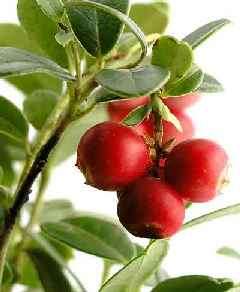
The Japanese Wineberry & other hybrid berries
Is vigorous and adaptable, ideal against a North or Easy wall or grown free standing at the rear of a shady border. Sometimes used as an ornamental because of it’s bristly shining red stems and palmate divided lime green leaves, the vermillion berries have an unusual but appealing flavour and can be used as a different dessert, or made into jellies. It will grow to 180cm’s in height and spread at least that.
There are other hybrid berry and Rubus species that will do well for you in sunless areas, including the close relative of the Blackberry, the Boysenberry which has luscious aromatic fruits on long canes. The Younbgerry would certainly do well, and so too the Veitchberry. Ideal if you want to trsy something different. These are all for larger areas, making quite vigorously upright to arching shrubs, but one that is a bit lower and can be left to do it’s own thing, forming colonies of rosy stemmed canes, is the Dewberry. This one does really well in shade, it is quite pretty with it’s divided leaflets – not as corse looking as a Blackberry – and the violet bloomed berries have a subtle fruits-of-of-the-forest flavour which can be enjoyed straight off the shrub, or used in preserves etc. Well worth trying!



